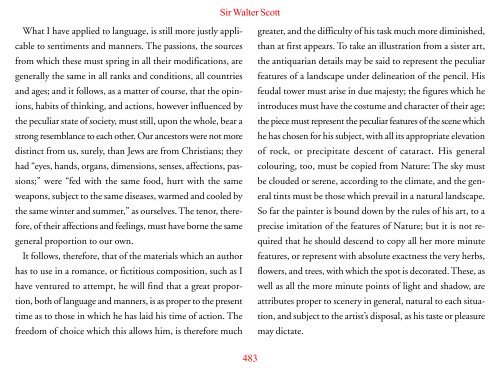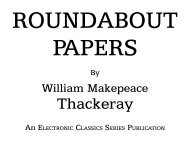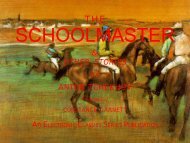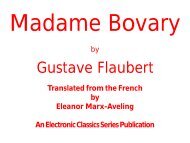- Page 1 and 2:
Ivanhoe by Sir Walter Scott A Penn
- Page 3 and 4:
Ivanhoe by Sir Walter Scott CHAPTER
- Page 5 and 6:
ace had shown the most marked predi
- Page 7 and 8:
leather was twined artificially rou
- Page 9 and 10:
“The curse of St Withold upon the
- Page 11 and 12:
—and thou art but a cast-away swi
- Page 13 and 14:
clasp, and the whole dress proper t
- Page 15 and 16:
also carried his small triangular s
- Page 17 and 18:
the Saxon peasants. “I asked you,
- Page 19 and 20:
oad, even if they should be in no h
- Page 21 and 22:
with his wooden sword.” “Ay, bu
- Page 23 and 24:
CHAPTER III Then (sad relief!) from
- Page 25 and 26:
His dress was a tunic of forest gre
- Page 27 and 28:
indignation without fear or control
- Page 29 and 30:
would himself bid them welcome, but
- Page 31 and 32:
and his shaven crown concealed by a
- Page 33 and 34:
they have not done me. I tell thee,
- Page 35 and 36:
seemed capable to kindle as well as
- Page 37 and 38:
sat Wamba, with a small table befor
- Page 39 and 40:
and hesitation, and many a bow of d
- Page 41 and 42:
I can cheer my dogs on the prey, an
- Page 43 and 44:
confusion of his guest; “I would
- Page 45 and 46:
will I bestow safely in the treasur
- Page 47 and 48:
CHAPTER VI To buy his favour I exte
- Page 49 and 50:
is the perverse course of fate, tha
- Page 51 and 52:
The inmate was lying in troubled sl
- Page 53 and 54:
Then, as if suspicion had overpower
- Page 55 and 56:
only a change of raiment.” Then g
- Page 57 and 58:
“May the wheels of their chariots
- Page 59 and 60:
head—ten goodly steeds, the worst
- Page 61 and 62:
pression of the feudal nobility, an
- Page 63 and 64:
front of the pavilions, and the who
- Page 65 and 66:
fer him injury. At such meetings th
- Page 67 and 68:
set of features, well formed by nat
- Page 69 and 70:
gland. But with the blood of this a
- Page 71 and 72:
steps which led up to the gallery.
- Page 73 and 74:
horror, “a Jewess!—We should de
- Page 75 and 76:
ing galleries were crowded with all
- Page 77 and 78:
espective shields. At the flourish
- Page 79 and 80:
ceiving, notwithstanding his place
- Page 81 and 82:
strained to the highest pitch. Few
- Page 83 and 84:
only saved from falling by being un
- Page 85 and 86:
“Your Grace,” said Waldemar Fit
- Page 87 and 88:
will be formal and complete.—Rais
- Page 89 and 90:
their silver, and their war-horses,
- Page 91 and 92:
sity of preparing for to-morrow’s
- Page 93 and 94:
CHAPTER X Thus, like the sad presag
- Page 95 and 96:
with pleasure exchange courtesies;
- Page 97 and 98:
Prince John willingly.” “Willin
- Page 99 and 100:
day’s tournament. It is the price
- Page 101 and 102:
Gurth grinned, which was his neares
- Page 103 and 104:
the carriages which had recently tr
- Page 105 and 106:
comes thy master by this gold? is i
- Page 107 and 108:
“Not if thou canst scathe him,”
- Page 109 and 110:
have had some trouble in finding hi
- Page 111 and 112:
sary of high reputation, were, neve
- Page 113 and 114:
antagonist to the extremity of the
- Page 115 and 116:
Meantime the clang of the blows, an
- Page 117 and 118:
the preceding day. This stood him i
- Page 119 and 120:
upwards of thirty were desperately
- Page 121 and 122:
There was a general consternation.
- Page 123 and 124:
A stern smile curled the Prince’s
- Page 125 and 126:
trial of skill, he was pleased to a
- Page 127 and 128:
“Now, Locksley,” said Prince Jo
- Page 129 and 130:
willow wand upright in the ground,
- Page 131 and 132:
posed of his domains without scrupl
- Page 133 and 134:
eign and domestic. But, though luxu
- Page 135 and 136:
free and independent right.” “W
- Page 137 and 138:
The knight made his obeisance, and
- Page 139 and 140:
“It will be in vain,” said Prin
- Page 141 and 142:
cause he opposed himself to the wil
- Page 143 and 144:
wealth and honour are but the lot o
- Page 145 and 146:
CHAPTER XVI Far in a wild, unknown
- Page 147 and 148:
oaks and holly bushes, whose roots
- Page 149 and 150:
“Friend wayfarer,” replied the
- Page 151 and 152:
those of a boar both in sharpness a
- Page 153 and 154:
countenance as was possible to be e
- Page 155 and 156:
more than he deserves who takes up
- Page 157 and 158:
“Ay, mark’st thou that?” repl
- Page 159 and 160:
Half shows, half shades, her neck o
- Page 161 and 162:
But which of us e’er felt the idl
- Page 163 and 164:
persed. Oswald, however, was antici
- Page 165 and 166:
their nation, wherein they indulged
- Page 167 and 168:
And the indignant swineherd resumed
- Page 169 and 170:
ceived he was rendering an importan
- Page 171 and 172:
the forest, Cedric and Athelstane r
- Page 173 and 174:
of the whole party, where Wamba,”
- Page 175 and 176:
“I have heard men talk of the ble
- Page 177 and 178:
tent with Wamba’s humour to trave
- Page 179 and 180:
good the old proverb, The nearer th
- Page 181 and 182:
mad? to give admittance to a knight
- Page 183 and 184:
e truer metal than the religion of
- Page 185 and 186:
full assurance that they held the r
- Page 187 and 188:
had too many good reasons for their
- Page 189 and 190:
my father feasted with Torquil Wolf
- Page 191 and 192:
ered us as bondsmen to the foreign
- Page 193 and 194:
CHAPTER XXII My daughter—O my duc
- Page 195 and 196:
in the slaughter-house. Each had in
- Page 197 and 198:
shalt lie, stripped of thy clothes
- Page 199 and 200:
those of others.” “I am, then,
- Page 201 and 202:
cruelty threatens. No silver will I
- Page 203 and 204:
pect from him.” “I know you not
- Page 205 and 206:
arm was to reconquer the Holy Sepul
- Page 207 and 208:
If, thought he, I should be moved b
- Page 209 and 210:
CHAPTER XXIV I’ll woo her as the
- Page 211 and 212:
protection.” “The presence of t
- Page 213 and 214:
fer to the supposed outlaw, conclud
- Page 215 and 216:
treaty or necessity.” “Stand ba
- Page 217 and 218:
“Let there be peace between us, R
- Page 219 and 220:
sacrifices. Our immense possessions
- Page 221 and 222:
necessary directions. “Let us see
- Page 223 and 224:
“Front-de-Boeuf has not recovered
- Page 225 and 226:
made, we do in Christian charity re
- Page 227 and 228:
All looked on each other, and were
- Page 229 and 230:
father did not give him any cause o
- Page 231 and 232:
hung upon his ancestor the alderman
- Page 233 and 234:
vent it.—Farewell.” “Farewell
- Page 235 and 236:
CHAPTER XXVII Fond wretch! and what
- Page 237 and 238:
“There is—there is,” answered
- Page 239 and 240:
irresistible horrors? What fate is
- Page 241 and 242:
nation of the head. “Thy penitent
- Page 243 and 244:
the open field by a well-fortified
- Page 245 and 246:
“What means the knave?” said Fr
- Page 247 and 248:
steady countenance, “is my affian
- Page 249 and 250:
to ire are these unhallowed laymen!
- Page 251 and 252:
“Away with this prating dotard,
- Page 253 and 254:
Ishmael and of Edom,” whispered I
- Page 255 and 256:
vulnerary remedies as her art presc
- Page 257 and 258:
few and brief directions were given
- Page 259 and 260:
cure wounds, though we deal not in
- Page 261 and 262:
“Let it be as thou wilt,” said
- Page 263 and 264:
In this deplorable condition the Je
- Page 265 and 266:
CHAPTER XXIX Ascend the watch-tower
- Page 267 and 268:
introduction. “If I could but dra
- Page 269 and 270:
“None of mark and distinction tha
- Page 271 and 272:
She turned her head from the lattic
- Page 273 and 274:
wing of the night raven. Nothing ca
- Page 275 and 276:
of honour and generosity. “How li
- Page 277 and 278:
plates of iron to fence it withal,
- Page 279 and 280:
part of the defenders’ observatio
- Page 281 and 282:
instantly summoning up his wonted r
- Page 283 and 284:
from the battlements of the castle;
- Page 285 and 286:
CHAPTER XXXI Once more unto the bre
- Page 287 and 288:
pose. Wherefore, one of ye go to Lo
- Page 289 and 290:
“Do you give ground, base knaves!
- Page 291 and 292:
“Go to the barbican,” said the
- Page 293 and 294:
to the postern, and having there de
- Page 295 and 296:
Rowena—see but her long dark lock
- Page 297 and 298:
The black cloud is low over the tha
- Page 299 and 300:
CHAPTER XXXII. Trust me each state
- Page 301 and 302:
as neither I nor any of mine will t
- Page 303 and 304:
should thirst, she has many a butt
- Page 305 and 306:
silvan amphitheatre, and took the s
- Page 307 and 308:
Locksley now proceeded to the distr
- Page 309 and 310:
prisoner, rescue or no rescue. I di
- Page 311 and 312:
know its vigour. “Now, Priest,”
- Page 313 and 314:
my mails, tell down with all speed
- Page 315 and 316:
pay for walking on Watling-street,
- Page 317 and 318:
all that may stir up the rude and u
- Page 319 and 320:
how thou mayst deserve my good word
- Page 321 and 322:
“Nay, but, good Diccon Bend-the-B
- Page 323 and 324:
oken by Latin, it had not held so l
- Page 325 and 326:
not only for the good which he perf
- Page 327 and 328:
“What is to be done?” said the
- Page 329 and 330:
“Not so,” answered Fitzurse;
- Page 331 and 332:
tunes, those of thy comrades, thine
- Page 333 and 334:
aton of office, and assuming a loft
- Page 335 and 336:
despised Children of the Promise ar
- Page 337 and 338:
Templars, and bringing great dishon
- Page 339 and 340:
hath prescribed to us in the forty-
- Page 341 and 342:
no more be known among the nations.
- Page 343 and 344:
from thee thy business with Brian d
- Page 345 and 346:
simplicity is no match for this dee
- Page 347 and 348:
Sir Walter Scott audacious Bois-Gui
- Page 349 and 350:
“It were deep pity,” said Conra
- Page 351 and 352:
or even to lose my Preceptory, for
- Page 353 and 354:
“Malvoisin, they must be found,
- Page 355 and 356:
y two scribes, chaplains of the Ord
- Page 357 and 358:
pleasure. But when the raging wolf
- Page 359 and 360:
most frantic excess of chivalrous z
- Page 361 and 362:
limbs, by a miraculous balsam. The
- Page 363 and 364:
The guards were about to remove her
- Page 365 and 366:
pet of the turret, and there take t
- Page 367 and 368:
CHAPTER XXXVIII —There I throw my
- Page 369 and 370:
“Thou sayest right, brother,” s
- Page 371 and 372:
“Is there,” said Rebecca, “an
- Page 373 and 374:
trust that the child of thy house y
- Page 375 and 376:
They embraced accordingly, and depa
- Page 377 and 378:
“Ay,” replied the Templar, “t
- Page 379 and 380:
which warned thee to demand a champ
- Page 381 and 382:
power will I forego, even now when
- Page 383 and 384:
daughter of Jacob must be otherwise
- Page 385 and 386:
efuse to act the brutality which hi
- Page 387 and 388:
arguments by which he endeavoured t
- Page 389 and 390:
them with his eyes, until they were
- Page 391 and 392:
patience. And now, farewell!” Iva
- Page 393 and 394:
amused the Knight, but compelled hi
- Page 395 and 396:
“I would, Wamba,” said the knig
- Page 397 and 398:
“Marry, sir, but we have Malvoisi
- Page 399 and 400:
his lance, and taking aim, not at t
- Page 401 and 402:
I have allotted thee, thou diest—
- Page 403 and 404:
the good men around, if it was not
- Page 405 and 406:
CHAPTER XLI All hail to the lordlin
- Page 407 and 408:
have sought out. The young knight s
- Page 409 and 410:
Men of their precarious course of l
- Page 411 and 412:
There are few more beautiful or str
- Page 413 and 414:
were rude. If sorrow was thirsty, t
- Page 415 and 416:
and loose black mantles, suited wel
- Page 417 and 418:
the mother of Athelstane, in her de
- Page 419 and 420:
each other.—And, how now, worthy
- Page 421 and 422:
and water for three days, which see
- Page 423 and 424:
He had indeed now many more auditor
- Page 425 and 426:
“Ay, by my faith!” said Athelst
- Page 427 and 428:
CHAPTER XLIII Be Mowbray’s sins s
- Page 429 and 430:
“That is impossible,” said the
- Page 431 and 432: eyes were now turned to the Precept
- Page 433 and 434: ing that his adversary is an unbeli
- Page 435 and 436: “Tempter,” said Rebecca, “beg
- Page 437 and 438: of our Order hast thou ever been, y
- Page 439 and 440: efore them; and the Black Knight ga
- Page 441 and 442: a wild march, of an Oriental charac
- Page 443 and 444: ers—But let us haste to the castl
- Page 445 and 446: the noble Saxon, that, ere he had b
- Page 447 and 448: laboured drudge, which stoops betwe
- Page 449 and 450: affection, and they loved each othe
- Page 451 and 452: e more natural, than that the Templ
- Page 453 and 454: NOTE TO CHAPTER XXII. Note E.—The
- Page 455 and 456: determined to prove gif a collation
- Page 457 and 458: sented to him, of the contents of w
- Page 459 and 460: house of Cassilis are still in poss
- Page 461 and 462: the holiest offices of the priestly
- Page 463 and 464: access to which is very ingenious,
- Page 465 and 466: in a steep direction to prop and su
- Page 467 and 468: INTRODUCTION TO IVANHOE. The Author
- Page 469 and 470: It is not, perhaps, necessary to en
- Page 471 and 472: twixt the monarch’s outward appea
- Page 473 and 474: host on a point to which he had mor
- Page 475 and 476: ondly, it conveyed no indication wh
- Page 477 and 478: has been recorded in the following
- Page 479 and 480: capable of being reanimated even by
- Page 481: hope to traverse by the following c
- Page 485 and 486: proportion to their knowledge of th
- Page 487: To return to the Electronic Classic

















